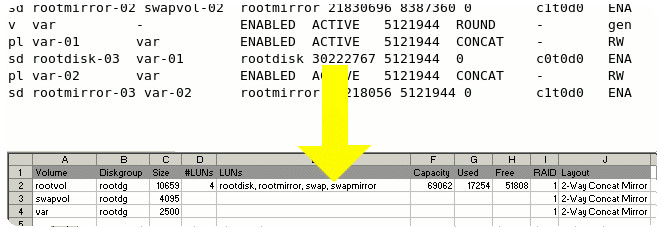Veritas Volume Manager Translator
Understand vxprint !
What Does it Do?
In a nutshell, it takes difficult-to-understand VxVM data and turns it into a very usable spreadsheet. Specifically, it takes vxprint output, and creates CSV spreadsheets, for use in Microsoft Excel, OpenOffice.org, or your favourite spreadsheet application.
Actually, it can also take the output of the cfg2html tool (which basically just includes a vxprint -Ath output).
So - you can use any of the following:
vxprintoutputvxprint -Athoutput (akavxprint -t)- cfg2html output
The CSV file, when downloaded, will have default column widths, which will not suit your needs; for presentation purposes, you will need to resize the column widths. The easiest way to do that is to Edit->Copy from this sample, and then in your CSV file, Edit->Paste Special and select "Column Widths".
Not only that, but
see what happens when you resize the volumes. See that the "Used" and "Free" totals are updated automatically; You will never need to work out volume sizes for yourself ever again.
Veritas, this tool, and Excel, will do the job for you.
The only link that you have been missing, is this tool.
One thing to note, is that the "Capacity" column shows the total available capacity of the diskgroup. Spreadsheets are not sufficiently intelligent to deal with scenarios whereby you have a mixture of RAID layouts, so - for example - if you have 2 x 73Gb disks, mirrored, with 30Gb used: that will be shown as 2x73 = 146Gb Capacity, 30Gb Used, 116Gb Free. In reality, you will be able to add only 43Gb worth of new mirrored volumes, though you could add 86Gb of RAID0 storage. In other configurations, you may be able to add RAID 5 or RAID 1+0 (RAID10) storage, leading to other calculations of the total capacity available.
As a result, the spreadsheets generated by this tool, assume optimal use of the rootdisk.
When Spreadsheet calculations are disabled, it would be possible for the script to calculate the actual usages. If Spreadsheet calculations are enabled (a rather useful feature, I find), this would make no sense, as the spreadsheet software does not know your LUN sizes, etc). This will be considered if someone gets in touch and requests it. Otherwise, I don't need it; we tend to use SAN (Hardware RAID5; VxVM RAID 0) or local disk (Mirrored, in which case I just halve the Capacity cell).
Veritas Volume Manager (VxVM) is a popular and powerful, enterprise-class storage management tool. When
you want to inspect a large setup (or sometimes even a small one!), its output (vxprint) can be unclear, even cryptic. Here is a small (root, swap, /var) configuration:

It is difficult (though possible) to tell from the text output of vxprint, how much space is used where, how the storage is laid out, and what is available for new volumes.
So what we have here is a free, online tool which converts the 16 lines gibberish above into 3 lines (or 218 lines to 30 lines in the other example) in a nice, clean spreadsheet, which explains the configuration and sizes of your volumes.
Download the sample, and play about with it, to see what happens when you resize different volumes. You should see that the "Used" and "Free" totals are updated automatically.
This is a tool which I use on a regular basis to create CSV (spreadsheet) files automatically. You can open and edit the CSV with Microsoft Excel, OpenOffice.org, or just about any spreadsheet software made.
How To Use It
The machine you want to report on may not have internet access and spreadsheet software, so it is likely that you will need to transfer some files.
There are two files involved: The first, is what you create on the machine:
# vxprint -Ath > /tmp/vxprint.txtYou will probably need to copy this file to your desktop PC, which you use to access the web. Then, just hit the button above, to locate "Your vxprint File", optionally select a title, and hit the Interpret Veritas File button.
This generates the second file, the CSV which should automatically open up in Microsoft Excel, OpenOffice.org, or the spreadsheet of your choice.
For formatting, I tend to use this sample, zoomed to 75% (View -> Zoom -> 75%). To copy this formatting, just copy mine, then do "Edit -> Paste Special", and choose "Column Widths".
Excel Calculations
You may have noticed that there is an "Excel Calculations" option; if that is selected, then the CSV will include the necessary formulae to automatically update the "Used" and "Free" columns, when you edit the spreadsheet. If you prefer, you can turn this off by deselecting the option.